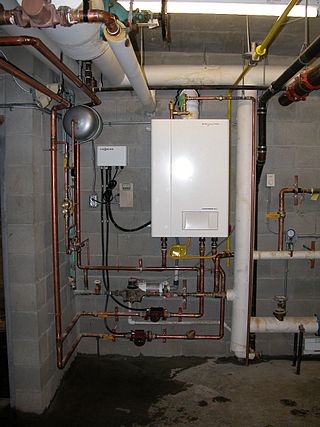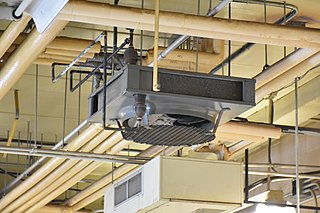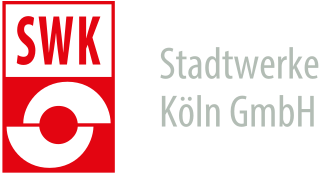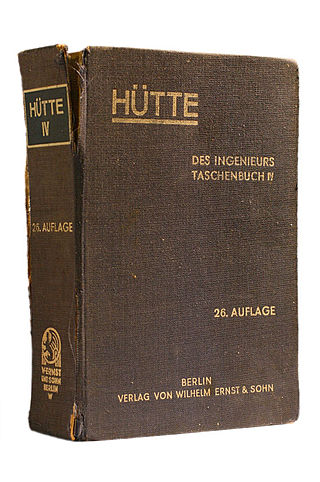
A dehumidifier is an air conditioning device which reduces and maintains the level of humidity in the air. This is done usually for health or thermal comfort reasons or to eliminate musty odor and to prevent the growth of mildew by extracting water from the air. It can be used for household, commercial, or industrial applications. Large dehumidifiers are used in commercial buildings such as indoor ice rinks and swimming pools, as well as manufacturing plants or storage warehouses. Typical air conditioning systems combine dehumidification with cooling, by operating cooling coils below the dewpoint and draining away the water that condenses.
Telefunken was a German radio and television producer, founded in Berlin in 1903 as a joint venture between Siemens & Halske and the Allgemeine Elektrizitäts-Gesellschaft (AEG) . Prior to World War I, the company set up the first world-wide network of communications and was the first in the world to sell electronic televisions with cathode-ray tubes, in Germany in 1934.

A central heating system provides warmth to a number of spaces within a building from one main source of heat. It is a component of heating, ventilation, and air conditioning systems, which can both cool and warm interior spaces.

An injector is a system of ducting and nozzles used to direct the flow of a high-pressure fluid in such a way that a lower pressure fluid is entrained in the jet and carried through a duct to a region of higher pressure. It is a fluid-dynamic pump with no moving parts except a valve to control inlet flow.

Hydronics is the use of liquid water or gaseous water (steam) or a water solution as a heat-transfer medium in heating and cooling systems. The name differentiates such systems from oil and refrigerant systems.

A thermal power station, also known as a thermal power plant, is a type of power station in which the heat energy generated from various fuel sources is converted to electrical energy. The heat from the source is converted into mechanical energy using a thermodynamic power cycle. The most common cycle involves a working fluid heated and boiled under high pressure in a pressure vessel to produce high-pressure steam. This high pressure-steam is then directed to a turbine, where it rotates the turbine's blades. The rotating turbine is mechanically connected to an electric generator which converts rotary motion into electricity. Fuels such as natural gas or oil can also be burnt directly in gas turbines, skipping the steam generation step. These plants can be of the open cycle or the more efficient combined cycle type.

A surface condenser is a water-cooled shell and tube heat exchanger installed to condense exhaust steam from a steam turbine in thermal power stations. These condensers are heat exchangers which convert steam from its gaseous to its liquid state at a pressure below atmospheric pressure. Where cooling water is in short supply, an air-cooled condenser is often used. An air-cooled condenser is however, significantly more expensive and cannot achieve as low a steam turbine exhaust pressure as a water-cooled surface condenser.

A condensing steam locomotive is a type of locomotive designed to recover exhaust steam, either in order to improve range between taking on boiler water, or to reduce emission of steam inside enclosed spaces. The apparatus takes the exhaust steam that would normally be used to produce a draft for the firebox, and routes it through a heat exchanger, into the boiler water tanks. Installations vary depending on the purpose, design and the type of locomotive to which it is fitted. It differs from the usual closed cycle condensing steam engine, in that the function of the condenser is primarily either to recover water, or to avoid excessive emissions to the atmosphere, rather than maintaining a vacuum to improve both efficiency and power.
Condensing boilers are water heaters typically used for heating systems that are fueled by gas or oil. When operated in the correct circumstances, a heating system can achieve high efficiency by condensing water vapour found in the exhaust gases in a heat exchanger to preheat the circulating water. This recovers the latent heat of vaporisation, which would otherwise have been wasted. The condensate is sent to a drain. In many countries, the use of condensing boilers is compulsory or encouraged with financial incentives.

Vapor-compression evaporation is the evaporation method by which a blower, compressor or jet ejector is used to compress, and thus, increase the pressure of the vapor produced. Since the pressure increase of the vapor also generates an increase in the condensation temperature, the same vapor can serve as the heating medium for its "mother" liquid or solution being concentrated, from which the vapor was generated to begin with. If no compression was provided, the vapor would be at the same temperature as the boiling liquid/solution, and no heat transfer could take place.

J. P. Sauer und Sohn GmbH is a manufacturer of firearms and machinery and is the oldest firearms manufacturer still active in Germany. The products of this company are frequently referred to as Sauer.
Tengelmann Twenty-One KG is the Munich-based Holding of the Tengelmann Group, a family-owned company established in 1867. The company identifies as an active entrepreneurial family investor, currently holding shares in more than 50 companies in Europe and North America. The diverse portfolio includes large retailers such as OBI and KiK, the real estate company TREI, the energy consulting company Tengelmann Energie, the insurance company Tengelmann Assekuranz as well as Tengelmann Audit. Their affiliated investment companies Tengelmann Ventures, Emil Capital Partners and Tengelmann Growth Partners invest in Start-ups and Grown-ups in Europe and North America.
Wacker Chemie AG is a German multinational chemical company which was founded in 1914 by Alexander Wacker. The company is controlled by the Wacker family holding more than 50 percent of the shares. The corporation operates more than 25 production sites in Europe, Asia, and the Americas.

GE Power was an American energy technology company owned by General Electric (GE). In April 2024, GE completed the spin-off of GE Power into a separate company, GE Vernova. Following this, General Electric ceased to exist as a conglomerate and pivoted to aviation, rebranding as GE Aerospace.

The Viessmann Group is a German manufacturer of heating and refrigeration systems headquartered in Allendorf (Eder), Germany. With 22 production companies in 12 countries, distribution companies and representative offices in 74 countries and 120 sales offices throughout the world, Viessmann is international in its orientation. More than 54 percent of turnover is generated abroad. Since January 2022, the company is led by Martin Viessmann, Maximilian Viessmann (Group-CEO) and Ulrich Hüllmann (CFO). In April 2023, Viessmann announced that it would sell its heat pump division to its US competitor Carrier Global for €12 billion. The transaction was completed in January 2024, Max Viessmann joins the Board of Carrier Global
Founded in 1873, the Dieffenbacher Group, located in Eppingen in the administrative district of Heilbronn in Baden-Württemberg, is a family-run enterprise in the field of mechanical engineering, plant systems engineering, and construction. They develop and manufacture press systems and complete production systems for the wood composites, automobile, aerospace and recycling industries. In addition, the company develops power plants and process equipment for energy generation and waste heat recovery.

Stadtwerke Köln GmbH is the infrastructure and services company of the City of Cologne.

Kern & Sohn is a German manufacturer and distributor of precision scales force gauges and microscopes. It was founded in 1844 in Albstadt, Ebingen by Gottlieb Kern and its products are often referenced in nineteenth century international scientific publications. The business is currently run by the sixth generation of the Kern family, and is one of only two German companies from that period to remain family-owned throughout its history. Many of the scales and balances produced by Kern are exhibited at the Waagenmuseum in Balingen. It has 100 employees.

Scheidt & Bachmann GmbH is a German technology company, based in Mönchengladbach, North Rhine-Westphalia. The company provides railway signalling systems and payment systems for public transport, parking, and fuel retailers. Scheidt & Bachmann was founded in 1872.

The Hütte - Das Ingenieurwissen is a reference work for engineers of various disciplines. It was compiled for the first time in 1857 by the Akademischer Verein Hütte of the Königliches Gewerbe-Institut in Berlin, from which the association of German engineers Verein Deutscher Ingenieure (VDI) emerged. The authors were members of the association. The technical illustrations were created in woodcut technique by Otto Ebel. It is published in constantly revised editions to this day and is therefore the oldest German reference work still available today.















